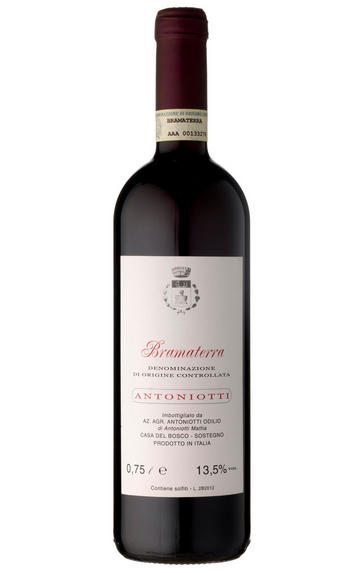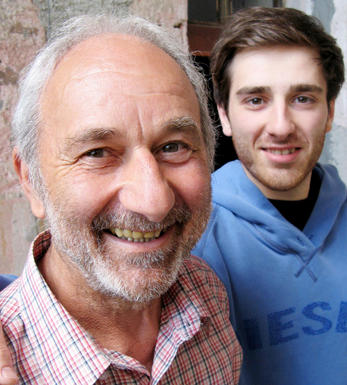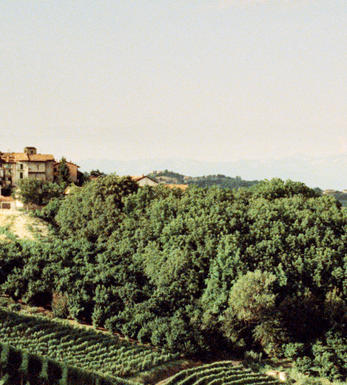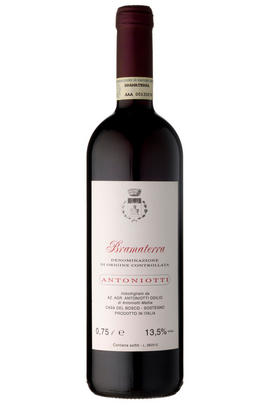
About this WINE

Antoniotti Odilio e Mattia,Piedmont
Mattia Antoniotti has joined his father Odilio at this historical 18th century cantina that is tucked away in the northern Alto Piedmont village of Sostegno, in the 100-hectare region of Bramaterra among the pre-Alps. They farm 4.8 hectares of Nebbiolo, Croatina, Vespolina and Uva Rara vines, the fruit of which Odilio first bottled in 1970 (prior to which Odilio was selling grissini and pharmaceuticals!). The Bramaterra soils are essentially volcanic porphyry, along with veins of rose quartz and limestone. The wines are traditionally made in cement, stainless-steel and large Slavonian oak botte, along with tonneau for the Nebbiolo wine.

Piedmont
Piedmont has long been renowned as Italy's premier fine wine province, with its reputation dating back to Roman times and further solidified under the House of Savoy, which wielded influence over Europe during the Middle Ages from its Turin stronghold. Piedmont's prominence in Italian history was notably highlighted as a driving force behind Italian Reunification in 1861.
Situated in the north-western part of Italy, Piedmont boasts a continental climate shaped by the nearby Alps and Ligurian Apennines, influencing both its culture and winemaking traditions. The region is home to several renowned fine wine areas, including the Langhe region, encompassing esteemed appellations such as Barolo and Barbaresco, as well as Monferrato, which features wines like Asti and Gavi, and Novara with its Colline Novaresi and Boca.
Nebbiolo reigns supreme as Piedmont's quintessential grape variety, with its stronghold in the production of illustrious wines such as Barolo and Barbaresco. Following closely are Barbera d'Alba or Barbera d'Asti, and Dolcetto, known for its role as an early-ripening antipasti wine, particularly around Dogliani. Among whites, Moscato takes center stage, crafting both the effervescent Asti and the more refined Moscato d'Asti.
Piedmont also produces notable red wines like Brachetto d'Acqui and popular dry whites such as Gavi, made from the Cortese grape. Remarkably, despite contributing only a small fraction to Italy's total wine production, Piedmont boasts the highest proportion of Denominazione di Origine Controllata (DOC) and Denominazione di Origine Controllata e Garantita (DOCG) wines.
For those seeking exceptional Piedmontese wines, recommended producers include Roberto Sarotto, Marinacci, Punset, Luisin, Roagna, Fratelli Alessandria, Trediberri, Vigneti Luigi Oddero, Marcarini, and E.Pira di Chiara Boschis, among others.

Nebbiolo
Nebbiolo is the grape behind the Barolo and Barbaresco wines and is hardly ever seen outside the confines of Piedmont. It takes its name from "nebbia" which is Italian for fog, a frequent phenomenon in the region.
A notoriously pernickety grape, it requires sheltered south-facing sites and performs best on the well-drained calcareous marls to the north and south of Alba in the DOCG zones of Barbaresco and Barolo.
Langhe Nebbiolo is effectively the ‘second wine’ of Piedmont’s great Barolo & Barbarescos. This DOC is the only way Langhe producers can declassify their Barolo or Barbaresco fruit or wines to make an early-drinking style. Unlike Nebbiolo d’Alba, Langhe Nebbiolo can be cut with 15% other red indigenous varieties, such as Barbera or Dolcetto.
Nebbiolo flowers early and ripens late, so a long hang time, producing high levels of sugar, acidity and tannins; the challenge being to harvest the fruit with these three elements ripe and in balance. The best Barolos and Barbarescos are perfumed with aromas of tar, rose, mint, chocolate, liquorice and truffles. They age brilliantly and the very best need ten years to show at their best.



Buying options
Add to wishlist
Description
The unique geology of the site means that their Bramaterra, vinified in cement rather than large French botti, remains toothsome and alive, and at only 13.5 percent alcohol, despite the heat of the vintage. In 2011 70 percent of the wine is Nebbiolo, giving the spine and refinement; 20 percent is Croatina, giving the ruby hue and pulpy generosity in youth; seven percent is Vespolina, a spicy relative of Nebbiolo; while the cherry on the torta is Uva Rara, all three percent of which lends an over-ripe fig or tamarind dimension. Blush, limpid, ruby-garnet, one can sense the heat of the vintage with sumptuous kirsch, mulberry and mountain herbal notes, with sun-dried redcurrants, and even dates. Crystal-clear, crunchy cranberry, the plummy Croatina gives way to finely poised raspberry essence, while the thrilling acidity makes for a wine that should develop well in bottle. Don't be in a hurry, give it time.
The historic Antoniotti family are from the village of Sostegno, in the region of Bramaterra famed for its volcanic porphyry, pink quartz and limestone soils which give its Nebbiolo-based wines such minerality. The son Mattia recently joined his father at the 4.8-hectare estate, where the wines are traditionally made in large 16-hectolitre Slavonian botti, a practice that started back in the 18th century
wine at a glance
Delivery and quality guarantee